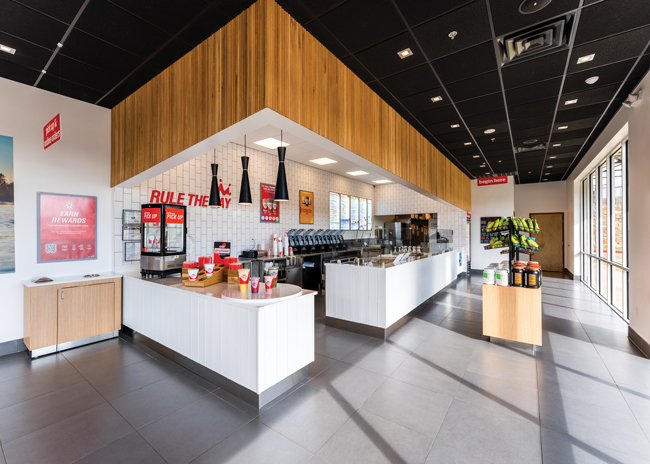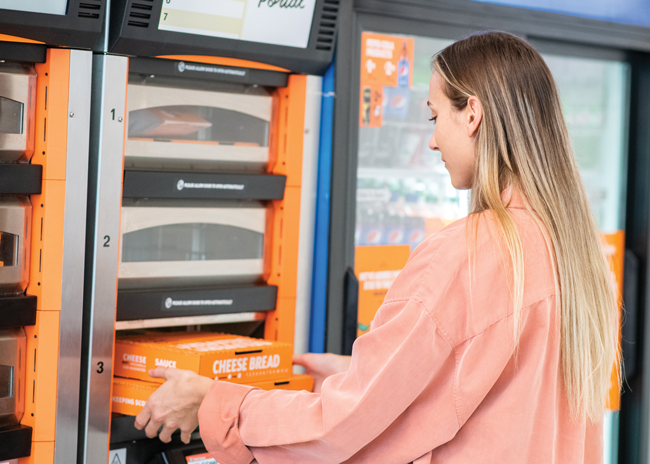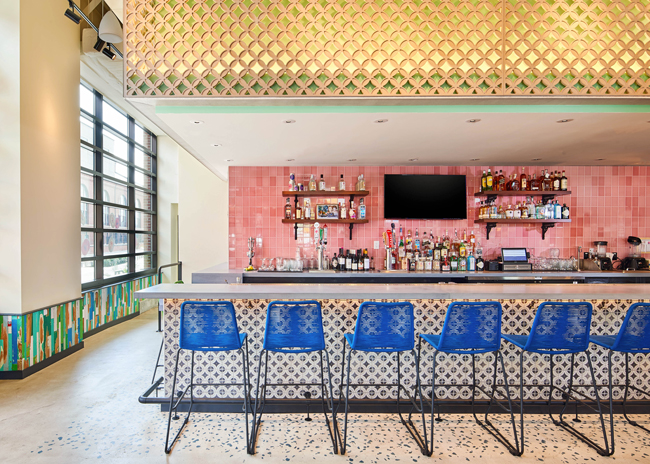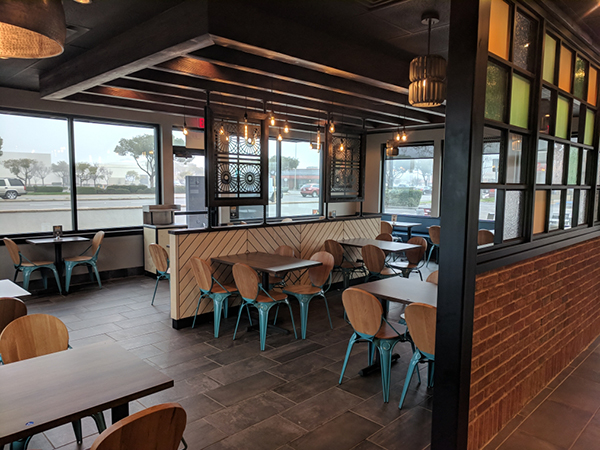Quick-service restaurant managers know full well the challenges of serving swarms of customers at the busiest periods of the day. But those who manage eateries in giant venues such as theme parks or arenas deal with a whole other level of volume. Disney World’s Magic Kingdom, for instance, entertains as many as 57,000 visitors a day, according to an unofficial estimate. Dining establishments serving thousands a day must design and plan for maximum efficiency or risk service meltdowns that annoy customers and could lead to social media posts that harm their brands.
Even small adjustments that improve efficiency, multiplied over the hours of operation, make a difference. At the highest volume restaurants, efficiency concerns impact how spaces are designed and used. While few restaurants experience the volume of business that Disney does, there are lessons to be learned and applied to smaller organizations.
 Dining establishments serving thousands a day must design and plan for maximum efficiency or risk service meltdowns that annoy customers and could lead to social media posts that harm their brands.
Dining establishments serving thousands a day must design and plan for maximum efficiency or risk service meltdowns that annoy customers and could lead to social media posts that harm their brands.
Commonly, the highest volume establishments tap expertise of industrial engineers who are steeped in optimizing operations of factories and other commercial enterprises for maximum productivity. Gina Masterson, principal, Masterful Consulting, who formerly designed restaurants for Disney, says looking through the lens of an industrial engineer is critical to planning a new high-volume eatery. At Disney, industrial engineers were consulted from the outset of new concept development. They were tasked with forecasting volume based on comparable existing dining outlets as well as contributing to design choices such as the size and layout of spaces.
As development of a concept progressed, one of Masterson’s first tasks was analyzing the habits of expected clientele. “If you are designing for a hotel that hosts lots of youth sports groups, for example, you can expect a big breakfast rush,” she says. In such an environment, plan to replenish offerings quickly. A wide variety of menu items places more stress on the back of the house, so a stripped-down menu aids this strategy. Self-serve options such as prepped and packaged sandwiches also enable efficient service for high-volume operations.
 Little Caesars’ Pizza Portal automates the pick-up process in a grab-and-go format.
Little Caesars’ Pizza Portal automates the pick-up process in a grab-and-go format.
Little Caesars, a pizza chain focused almost exclusively on takeout and delivery, employs best practices gleaned from industrial engineering to drive efficiency and even store design. Store sizes run as large as 1,400 square feet but scale down to less than 1,000 square feet. The chain has a time-tested formula that specifies the sizes of ovens, counter space and ingredient storage elements for optimal operation according to size of the store footprint. Such standardization, honed over the years with input from industrial engineering consultants, is essential for efficient operations, says Eric Brasseur, vice president, store engineering and equipment for Little Caesars.
The chain consistently scrutinizes operations, looking for ways to boost efficiency. In-house staff, augmented periodically with an outside perspective, are constantly engaged in that pursuit. “We’ve brought in industrial engineering consultants every three to five years,” Brasseur says. Competitive intelligence informs their work, as well. “We are constantly looking at what other brands are doing,” he says.
Several years ago, Little Caesars was invited to a Chick-fil-A innovation center where they looked at how “one of the best in the business” analyzes and refines operations, Brasseur says. Not being a direct competitor to the chicken sandwich chain, Little Caesars and Chick-fil-A executives could share insights without the fear of revealing closely held trade secrets to their competition.
The Beverage Question
Most restaurateurs underestimate the importance of drink service when thinking about efficiency, Masterson says. “People are usually most concerned about the kitchen, but beverage tends to be the biggest issue,” she says. Self-service beverage options are more efficient as back-of-the-house personnel not required to fulfill drink orders have more time to focus on preparing and serving food.
But where you place coffee and soda dispensers is critical. If, for example, you have a breakfast buffet line, segregate beverages from the food. Otherwise, people are likely to congregate around the coffee and slow the line. “If beverages are in the same line as the food, you’re never going to get your coffee,” Masterson warns.
To supply soda fountains, redundant ice machines were favored at Disney outlets. High-capacity ice machines situated behind the beverage station continuously fed ice to the soda dispensing machines. Conventional soda dispensers that made their own ice could not keep up with demand, so the back-up machines supplied the difference.
Little Caesars’ beverage strategy opts out of the ice-making challenge by eschewing soda fountains for bottled beverages. “This eliminates the potential of having a fountain that breaks down, and it reduces spills,” Brasseur says. The challenge for Little Caesars’ operators is to ensure that large two-door beverage refrigerators are well stocked ahead of the busiest dayparts.
 Smoothie King’s menu, posted on the back wall, groups drink types together in categories: “Feel Energized,” “Get Fit,” “Be Well,” and “Enjoy a Treat.” This strategy provides a logical framework for customers and helps them choose their order faster. Photo courtesy of Smoothie King
Smoothie King’s menu, posted on the back wall, groups drink types together in categories: “Feel Energized,” “Get Fit,” “Be Well,” and “Enjoy a Treat.” This strategy provides a logical framework for customers and helps them choose their order faster. Photo courtesy of Smoothie King
Planning for Failure
High-volume establishments choose equipment for durability and ease of maintenance. When things break down, they have contingency plans to minimize disruption to operations.
Little Caesars’ high standards for selecting equipment are borne from decades of experience working in a high-volume business model. “A vendor may tell us that this piece of equipment has worked well for other clients, but we have a whole other level of stress,” Brasseur says. “If there is some way for it to fail, we will find a way to have it fail.” The chain has developed a trusted stable of vendors whose products have proven themselves over the years. “We have 20-year-old dough mixers that keep going and going,” he says.
Maintenance and service report to Brasseur, and this organizational structure promotes regular feedback on the reliability of equipment to guide purchasing decisions as well as how often to replace key items. Brasseur’s team develops and refines maintenance schedules to prevent equipment failures. When things do break, maintenance staff have stockpiles of critical parts that are prone to wear out so they can quickly make repairs.
At Disney properties, engineering and maintenance departments had significant input on which brands and types of equipment were purchased. When shopping for equipment, pay close attention to warranty agreements just as you would for things like capacity and features, Masterson advises. Also, maintenance personnel need to be up to speed on the terms of warranties, and when something goes wrong, be able to obtain replacement equipment and parts quickly.
It’s good practice to have contingency plans in the event of equipment failure, Masterson adds. When a dishwashing unit went down at one Disney outlet, staff would temporarily bus dishes to another eatery nearby. It was also a good strategy for some stores to have two dishwashing units. When one failed, the other might be heavily taxed, but could keep churning out enough clean dishes to keep serving customers.
Safety features, too, can impact efficiency. Rather than choosing a chemical-based solution for stove hoods, Disney used a water-based system.
Water-based systems are easier to clean up than other chemical-based systems, and after a chemical system activates it must be recharged and inspected by the fire department. Water systems had no such inspection requirement. So, in the event of a fire, staff would be able to get a stove protected by a water system back online faster. Fryers, though, require chemical systems because they are necessary to put out grease fires.
 Little Caesars, which is focused almost entirely on takeout and delivery, employs best practices gleaned from industrial engineering to drive efficiency and even store design. Photo courtesy of Little Caesars
Little Caesars, which is focused almost entirely on takeout and delivery, employs best practices gleaned from industrial engineering to drive efficiency and even store design. Photo courtesy of Little Caesars
Getting the most out of technology
High-volume establishments look to new POS and order-tracking technology to speed up service. Smoothie King, which completes the payment process while the order is made, gives customers the option to order via a mobile app. Customers can pay in advance via the electronic payment option of their choice and present a QR code on their phone screen which staff can scan as proof of purchase.
“If queues get long, we can deploy staff with tablets to take orders,” says Chris Bremer, chief development officer for Smoothie King. As orders come in through the mobile app or when placed on-site, an operational system creates a paper ticket with a list of ingredients for the drink. This speeds up order fulfillment and improves accuracy as employees don’t need to memorize lists of ingredients or flip through manuals for recipes.
 Little Caesars’ Pizza Portal automates the pick-up process in a grab-and-go format. Photos courtesy of Little CaesarsLittle Caesars is so committed to technology for competitive advantage that it developed a proprietary homegrown system that manages all store operations. For instance, sites cook pizzas ahead of time for grab-and-go service. Software tracks the expiration time of each pie to ensure that all offerings are fresh. Prior to the pandemic, the company rolled out a Pizza Portal, a storage cabinet holding pre-paid pick-up orders. Customers open the compartment holding their order with a code sent to their mobile device.
Little Caesars’ Pizza Portal automates the pick-up process in a grab-and-go format. Photos courtesy of Little CaesarsLittle Caesars is so committed to technology for competitive advantage that it developed a proprietary homegrown system that manages all store operations. For instance, sites cook pizzas ahead of time for grab-and-go service. Software tracks the expiration time of each pie to ensure that all offerings are fresh. Prior to the pandemic, the company rolled out a Pizza Portal, a storage cabinet holding pre-paid pick-up orders. Customers open the compartment holding their order with a code sent to their mobile device.
As delivery service businesses blossomed during Covid, the company modified the system to accommodate delivery driver pick-ups. To give each store the ability to add additional Pizza Portals if an uptick in demand warrants it, the company designed a front counter with a 2-foot section that can easily be removed to accommodate an additional one. This is a good example of how some brands impart flexibility in design to enable modifications that aid efficiency.
 Customers can scan a QR code on their phone to unlock their order from Little Caesars grab-and-go storage unit.Little Caesars and other high-volume brands believe improving efficiency is a quest that is never finished. “As a value brand, it’s critical for us to minimize labor and cost,” Brasseur says. Given that guidepost, the company continues to test new technologies including robotics to produce satisfying meals quickly, at reduced cost.
Customers can scan a QR code on their phone to unlock their order from Little Caesars grab-and-go storage unit.Little Caesars and other high-volume brands believe improving efficiency is a quest that is never finished. “As a value brand, it’s critical for us to minimize labor and cost,” Brasseur says. Given that guidepost, the company continues to test new technologies including robotics to produce satisfying meals quickly, at reduced cost.
Technology might not always be advantageous and should be evaluated with a critical eye, though.
Nevertheless, any brand is well advised to stay abreast of new technologies that can make operations more efficient. Likewise, periodic reviews of operations for opportunities to improve efficiency, as is the practice of high-volume businesses, are well worth the effort.



